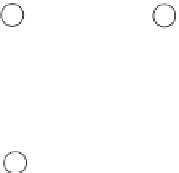Geoscience Reference
In-Depth Information
CLOUD FEEDBACK PROCESSES
Because of the complexities in simulating clouds and evaluating their influence on
climate, clouds are the greatest source of differences among climate model simula-
tions of future climate, and their role in future climate change is uncertain. There
are many different kinds of clouds with a wide range of albedos. Their distribu-
tions and the physical processes that create them vary with latitude and season.
Here, without much technical detail, is an overview of cloud feedback pro-
cesses. These feedbacks are difficult to evaluate because clouds interact with
both longwave and shortwave radiation. Clouds are important for determining
the planetary shortwave albedo at all latitudes and, being composed of water
vapor, ice, and liquid water, they also absorb and reemit longwave radiation.
Clouds are also influenced by aerosol distributions and types, and they are
coupled to the global water cycle.
As discussed in section 4.7, the global- and annual-mean cloud forcing (Eq.
4.38) is negative
(
2
=− so the net influence of clouds is to cool
climate. However, this does not imply that the cloud response to increasing
greenhouse gases will provide a negative feedback, since
F
C
can increase (be-
come less negative, or even become positive) or decrease as climate changes.
To study the role of clouds in climate change, various aspects of the cloud/
climate interaction are considered individually. First, consider cloud amount.
Will global cloud amounts increase or decrease in response to greenhouse gas
forcing? The answer is not known and will depend on a consideration of vari-
ous cloud types under various conditions. Assuming for the sake of argument
(and in agreement with many, but not all, climate model simulations) that
cloud amounts decrease when
T
* increases in response to greenhouse gas forc-
ing, we can diagram two feedback loops isolating cloud radiative processes—
one for the consideration of longwave fluxes and one for shortwave fluxes—in
Figure 11.2.
Note that with this assumption changes in cloud amounts provide
F
17.3/
W m),
C
(a) Cloud feedback: longwave considerations
(b) Cloud feedback: shortwave considerations
CO
2
+
CO
2
+
T*
T*
+
-
-
-
Solar
absorbed
Cloud
amount
Cloud
amount
OLR
-
+
-
+
Planetary
albedo
Longwave
trapping
Figure 11.2 (a) Longwave and (b) shortwave radiation feedback loops assuming
cloud amount decreases with increasing temperature.
















